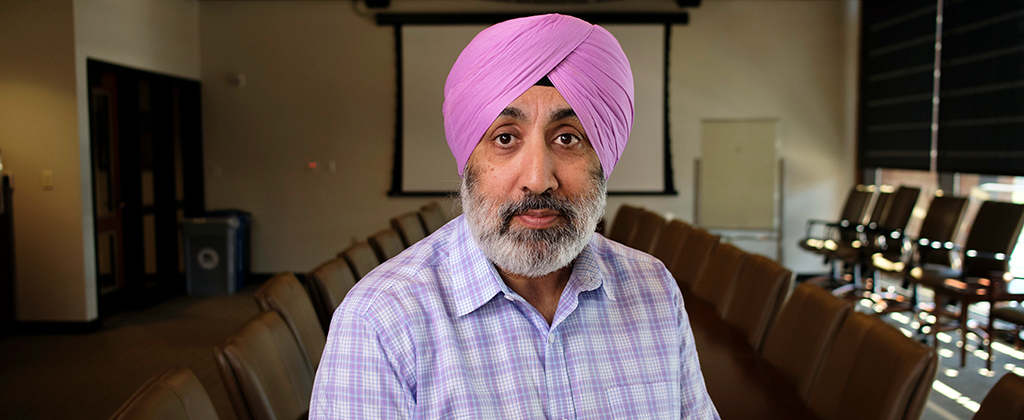Q&A with University of Tennessee Lean Manufacturing Expert Rupy Sawhney
The COVID-19 pandemic changed many things about the modern workplace. The abrupt closure of many workplaces forced a new era of remote work for millions and has led to the prospect of continued hybrid, remote, and telework opportunities.
However, according to data from the Pew Research Center, the majority of workers say their job responsibilities cannot be done from home. Jobs providing in-person care or customer transactions, operating machinery, or using lab equipment are some examples.
The Y-12 National Security Complex, operated by Consolidated Nuclear Security (CNS), is a premier manufacturing facility that plays a vital role in the National Nuclear Security Administration’s Nuclear Security Enterprise. Employees at Y-12 not only perform work to keep the nation safe, but also must keep personal safety, security, and wellness at the forefront of their daily operations.

Doug Freund
Doug Freund, CNS vice president for operations support, has been collaborating with UT Heath Faculty Fellow in Business and Engineering Rupy Sawhney, pictured above, for the last four years. Freund is a doctoral candidate, and his research focuses on why companies fail at sustaining continuous improvement initiatives through the lens of a leader.
Now, CNS and UT have partnered on an innovative new Human Behavior Lab located at Y-12. The lab is led by Sawhney, and seeks to address the central question, “How can work be designed to both maintain high productivity standards and increase employee wellness at the same time?”
“In collaboration with the Center for Advanced Systems Research and Education (CASRE) at UT, we have created a framework to develop, guide, and sustain an organization that excels at operational excellence using systems thinking and measuring the reliability of operations while improving employees’ quality of life,” said Freund.
What sets the lab’s work apart from other initiatives is its critical problem-solving approach—a people-centric model of operational excellence referred to as the “Sawhney Model.”
We sat down with Sawhney to discuss the Human Behavior Lab, the “Sawhney Model,” and some issues facing the modern workplace. The following interview has been lightly edited for clarity.
Q&A
Interviewer: The pandemic added stress to an already stressed workforce. What do you think are the top issues impacting our workforce today, two years into this “new normal?”
Sawhney: This general bias of productivity over employee wellbeing is fundamentally an issue that has never been resolved, and when people are put under pressure to choose one over the other, it is generally productivity that has priority. So, the basis of the problem is not new; however, the pandemic has caused two new issues because the workforce environment changed.
During the pandemic, we became a workforce with the ability to work from home. This is the first issue. Now we have to look at what impact working from home makes on employee workload, on their work tempo, on their autonomy to make decisions, on their flexibility. We can’t simply say we’re sending people home to work without addressing, for example, if working from home means employees are only working from 9 a.m. to 5 p.m. Or addressing, for example, that previously employees set up appointments that were 9 to 10 a.m. with a 15-minute break before going to another meeting, but now, with virtual meetings, everything is back-to-back.
The second issue is considering how to bring employees back to the workplace. Some people are choosing not to go back to work, and the question everyone wants to know is, “What would motivate people to come back?”
So, rather than trying to answer those questions by intuition or past experience, we are looking at the fundamental science behind it. We are asking questions such as: what kind of behavior can we learn from how people work at home? What active use of those behaviors can we bring back into the workplace?
Interviewer: “The Sawhney Model, Operational Excellence for the People, by the People,” is the scientific model you used previously, for example on the big productivity project you completed with Clayton Homes. This model also forms the basis for your new Human Behavior Lab at Y-12. For the modern business leader, could you explain some principles behind how you use this systems-based approach to solve today’s most pressing workplace issues?
Sawhney: In the laboratory at Y-12, we focus on the idea that the workplace keeps pushing people into circumstances where they have to make a decision between productivity and well being. We want to discover what we can do to change these circumstances. We pursue this change through concepts of reliability—designing a reliable system that will provide the materials, the people, the information, and the equipment. That is the basis of this design. The last thing we do is, in essence, look at how motivation, engagement, culture, and people’s feelings impact work. We look at the risk associated with people not being aligned in either their motivational engagement or cultural alignment.
For business leaders, the first thing to know about our model is that taking care of people does not mean we swing the pendulum all the way over where we’re not taking care of business. We want an approach that is balanced between the two. [In the Sawhney Model] our fundamental belief is that a leader can not only take care of productivity but can also take care of employee well being and retention. I would add that in many organizations, retention is an even bigger issue than productivity.
Employees are leaving companies and so business leaders use their intuition to try to do something to stop this – provide free lunch, for example. But the issue that needs to be considered is: why?
Looking at systems and system behavior gives us insight. For example, looking at a manufacturing process from a systems approach, I might see a production bottleneck. My first question is: does that system already have labels of certain people being productive and others being non-productive? If so, are more resources being allocated toward highly productive people being more productive rather than toward less productive people being capable? For the less productive people, are they less productive because they have simply not been given the resources or opportunities?
We look at those behaviors from a systems perspective and decompose it so we can understand the relationship between operations manufacturing and how people behave. We believe if we can understand and predict behavior, we can change behavior. And if we change the behavior, the bottleneck is scalable. That is our first principle.
Another principle is the relationship between what an employee does and what the impact is. Of the thousands of people [my research team] has presented this to, most do not understand the relationship between action and motivation or the science behind it.
Leaders need to be able to communicate to their employees what the work is, propose a strategy, and explain how the strategy will achieve a positive outcome and fill a void or gap. These actions provide motivation, which affects employee well being and productivity. In addition, within that same principle, is what we call “the retention construct.” For leaders, this construct answers the question: “If I’ve communicated these things effectively, what impact does it have on my employees?”
Traditionally most organizations do an annual survey, have an annual picnic, or that sort of thing, but these activities do not provide measurement or understanding of impact. In our model, we collect data related to action and motivation. These data help us communicate to leaders about using the data to determine the impact, rather just relying on observation or intuition.
The next principle is that most work being done on a job is categorized as reactive work, meaning we are spending our time responding to things we were not anticipating. For example: “I don’t have this material I need to do the work I planned. My co-worker did not send me this material, so let me go do something else or let me call my co-worker and find out where this is.” That scenario makes up a lot of the work we do.
In our model, we create systems for changing reactive work to proactive work. These systems allow employees to be capable of both finishing their work and reduce their stress. So, proactive work can increase productivity and employee wellness at the same time.
Sawhney’s work in Lean Production, workforce development, and human behavior analysis has been widely published in academic journals over the past twenty years. Most recently his paper, “Developing a robust measurement instrument for the influence of national culture on lean production systems,” appeared in the journal Measuring Business Excellence.
—
CONTACT:
Tyra Haag (865-974-5460, tyra.haag@utk.edu)
Chris Schmitz (876-974-8304, cschmit26@utk.edu)
